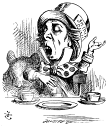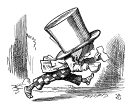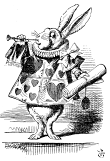Search us!
Search The Word Detective and our family of websites:
This is the easiest way to find a column on a particular word or phrase.
To search for a specific phrase, put it between quotation marks. (note: JavaScript must be turned on in your browser to view results.)
Ask a Question! Puzzled by Posh?
Confounded by Cattycorner?
Baffled by Balderdash?
Flummoxed by Flabbergast?
Perplexed by Pandemonium?
Nonplussed by... Nonplussed?
Annoyed by Alliteration?

Don't be shy!
Send in your question!
Columns from 1995 to 2006 are slowly being added to the above archives. For the moment, they can best be found by using the Search box at the top of this column.
 If you would like to be notified when each monthly update is posted here, sign up for our free email notification list.
If you would like to be notified when each monthly update is posted here, sign up for our free email notification list.
Trivia
All contents herein (except the illustrations, which are in the public domain) are Copyright © 1995-2020 Evan Morris & Kathy Wollard. Reproduction without written permission is prohibited, with the exception that teachers in public schools may duplicate and distribute the material here for classroom use.
Any typos found are yours to keep.
And remember, kids,
Semper Ubi Sub Ubi
|
And if you’re not in New York City, that’s not a real bagel. Sorry.
Dear Word Detective: Recently the term “egg cream” was mentioned on a newsgroup I frequent, and this led to the question of why a concoction that contains neither eggs nor cream should have that name. (And when I searched your website, I was surprised to find no listing for “egg cream.” Did I miss it? I can’t believe an ex-pat New Yorker such as yourself would have missed it. I also moved away from New York many years ago, but, as a friend of my puts it, “I still have my passport.”) One of the members said that her husband raised the question of ingredients whenever anyone mentioned “egg creams” and said he just couldn’t let it go. I wrote back to ask if she had broken the news about “baby oil” to him. This led to a total digression into posts about what exactly goes into “Girl Scout cookies,” “moth balls,” etc., not to mention oxymorons like “Holy Roman Empire” (which wasn’t Holy, Roman or an Empire) and the “German Democratic Republic” (the former East Germany). And this leads to our two questions: (1) What is is the origin of the term “egg cream,” and did some early version of the beverage actually contain eggs, cream or both? (2) Is there a word for ambiguous constructions like “Girl Scout cookies” and the like? It seems that someone ought to have coined one by now. (If not, I may have to take a stab at it. One of my coinages – “webmosis” – as in “I picked up my knowledge of 18th century salad forks by sheer webmosis” – has actually come back to me in a note from a total stranger since I’ve released it into the wild. — Joe.
Well, to answer your second question first (after shortening the whole shebang a bit, sorry), I don’t know of any term for such ambiguous terms as “moth balls,” but if you can think of one, go for it. “Webmosis” is great. Incidentally, I loved the smell of moth balls as a kid, which may explain my lack of coordination in gym class and all sorts of other things later on.
I actually did write a column on “egg cream” many years ago, but that was back when I wrote for the New York Daily News, so it’s not on my website. The “egg cream” is the quintessential New York City drink, made with seltzer, whole milk and chocolate syrup, stirred with a long-handled spoon and served in a small glass. For connoisseurs, the only proper chocolate syrup to use in an egg cream is Fox’s U-bet, made, of course, in Brooklyn.
By now attentive readers will have noticed that neither eggs nor cream appear in that recipe, and there’s some debate as to whether they ever did. The egg cream is generally agreed to have been introduced in the early 1900s at a candy store owned by Louis Auster on Manhattan’s Lower East Side. Inexpensive fountain drinks were popular in those days (including the classic “two cents plain” glass of seltzer), so it’s entirely possible that Auster simply perfected and popularized an existing concoction rather than actually inventing the egg cream, but he gets the credit anyway. As for the ingredients, some accounts say the original drink was made from syrup containing eggs and cream, others say that “egg” in the name is just an Anglicized form of the Yiddish “echt,”meaning “genuine” or “real,” and still others say that the name “egg cream” was never meant to be taken literally and simply referred to the taste of the drink. Hey, we’re talking New York here — you expected just one opinion?
By the early 20th century, the egg cream was being dispensed by the millions in every drugstore, soda fountain, candy store and delicatessen in the five boroughs of New York City. The great thing about egg creams is that they don’t last — they should be consumed as soon as they’re made or the milk and seltzer separate and the whole thing goes flat — so no one has ever been able to bottle a real egg cream. I assume that there are still plenty of places in NYC to find a decent egg cream, but if all else fails, try outer Brooklyn. And it’s possible that you can find something called an “egg cream” in Pittsburgh or Des Moines if you really search, but don’t bother. Like pizza, if you’re not in New York City, it’s gonna be a bad joke.
Ministry of Un-silly Walks.
Dear Word Detective: I’m listening to Tom Waits’ song “Walking Spanish” and wondering: what is the etymology of this macabre phrase? — Topi.
Tom Waits? The strangest things turn up in this column. Not that there’s anything wrong with Tom Waits. I recognize that he’s a very talented singer-songwriter. My only problem is his voice, which, according to Wikipedia, was once described by a critic as sounding “like it was soaked in a vat of bourbon, left hanging in the smokehouse for a few months, and then taken outside and run over with a car.” Remember that business back in the 1990s when The New England Journal of Medicine documented the case of a 45 year-old woman who had seizures whenever she heard Mary Hart’s voice? Tom Waits is my Mary Hart. A Tom Waits duet with Van Morrison would probably do me in for good.
The song “Walking Spanish” is, at least on the surface, about a condemned prisoner walking to his execution, and the phrase in question concludes each verse (e.g., “Tomorrow morning there’ll be laundry, But he’ll be somewhere else to hear the call, Don’t say goodbye, he’s just leaving early, He’s walking Spanish down the hall”). From this we can conclude that “walking Spanish” is not something done voluntarily, and indeed the Oxford English Dictionary defines the phrase as “to (cause to) walk under compulsion, properly with someone holding the collar and the seat of the trousers.”
The phrase dates to the early 19th century, and has been used both literally (with the subject being under the sort of physical restraint described above) and figuratively, where the person is compelled to leave a job, the premises or the country, etc., unwillingly. Brewer’s Dictionary of Phrase and Fable (1894) provides an example of the figurative “dismiss” or “fire” sense from 1885: “If I had to deal with the fellow, I would soon make him walk Spanish, I warrant you.”
The question, of course, is what makes a “Spanish walk” Spanish in any sense. The simplest (and probably most likely) explanation is that the phrase is just another example of the use of “Spanish” as a derogatory modifier in a wide range of English idioms. This would put “Spanish walk” in the same category as “Spanish castle” (a daydream unlikely to be realized), “Spanish disease” (syphilis) and “Spanish padlock” (a chastity belt). Many of these phrases reflect the national rivalry between Spain and England in the 16th and 17th centuries, just as such phrases as “French leave” (desertion) and “Dutch act” (suicide) echo England’s periods of enmity towards France and the Netherlands.
There is, however, a possibility that “Spanish walk” has a somewhat less derogatory origin. In dressage, the art of training horses to move in precise, sometimes elaborate fashions, “Spanish walking” (presumably named after a style of dressage fashionable at one time in Spain) is a style of walking in which the horse swings its forelegs forcefully straight forward with each step. The effect is roughly similar to soldiers marching in “goosestep,” and a person being involuntarily marched in a “Spanish walk” might approach such a stiff-legged gait.
There’s food on your forehead.
Dear Word Detective: A common word I always found peculiar is “napkin.” Is there an English derivation for this? Any relation to “bodkin” or “pumpkin”? — Jim McGovern.
I actually answered a question about “napkin” many years ago, and the explanation of the word that my correspondent had heard from her mother was so bizarrely creative that I think it’s worth quoting her email to me: “My mother maintains that a ‘napkin’ used to be a kind of blanket that one would sleep (‘nap’) under, and that when the napkin was worn out people would cut it up into smaller pieces to use at the dinner table.” Eventually, I suppose, these “napkins” were cut into even smaller pieces and used by Mrs. Housemouse to cover her little mouse-children in their tiny matchbox beds. And baby bedbugs need bankies too, so I’ll bet it’s napkins all the way down.
As I explained at the time, the “nap” in “napkin” has nothing to do with the pleasant snooze you sneak at your desk after lunch. That “nap” comes from the Old English word “hnappian,” meaning “to doze or sleep lightly.” There’s also no connection between the “nap” in “napkin” and “nap” meaning, as the Oxford English Dictionary (OED) defines it, “the rough layer of projecting threads or fibers on the surface of a woolen or other textile fabric,” which comes from an Old English word meaning “to pluck.”
The root of our English word “napkin,” which first appeared in the 16th century meaning, as it does today, “A usually square piece of cloth, paper, etc., used at a meal to wipe the fingers and lips and to protect the clothes” (OED), lies in Latin. The Latin word “mappa” means “cloth,” and the same “mappa” also gave us our word “map.” When “mappa” was carried into Old French, the “m” became an “n,” producing “nappe,” which entered English as “nape,” a now obsolete word meaning “cloth.”
That same “nappe,” by the way, gave us the English “apron,” which was, in English, originally “napron.” Through a linguistic process known as metanalysis, the initial “n” of “napron” in the phrase “a napron” drifted over and fused to the article, producing “an apron.” Such metanalysis also transformed “a nadder” into “an adder” and the 14th century “noumpere” (from the French, literally “not a peer”) into our modern “umpire.”
Meanwhile, back at “nape” meaning “cloth,” back in the 13th and 14th centuries it was common to add the suffix “kin” to words, at first mostly proper names, in order to create a diminutive form. Beginning in the 15th century, this “kin” (which has roots in Dutch and is unrelated to “kin” in the sense of “family”) was appended to a fairly small number of nouns to add the sense of “small,” and “napkin” was such a case, giving it the logical sense of “small cloth.”
It’s actually unclear whether the diminutive “kin” in “napkin,” signifying “small,” carries the same meaning in either “pumpkin” or “bodkin” (meaning a dagger, needle or other sharp implement). The original form of “pumpkin” in English was “pumpion” (from the Latin “peponem,” melon), and the origin of “bodkin” is a complete mystery. Both words were apparently modified to end in “kin” as was common at the time, but neither word really carries that sense of “small.” Pumpkins are actually rather large for melons.
Incidentally, that “bodkin” has nothing to do with “Odd’s bodkins,” an emphatic oath meaning literally “God’s dear body!” common in 16th and 17th century English literature and a favorite of Shakespeare. The “bodkin” in the oath is actually a variant of “bodikin,” a diminutive (or, by extension, familiar or affectionate) form of “body.”
|
Makes a great gift! Click cover for more.  
400+ pages of science questions answered and explained for kids -- and adults!
FROM ALTOIDS TO ZIMA, by Evan Morris
 
|


 can be found
can be found 




Recent Comments